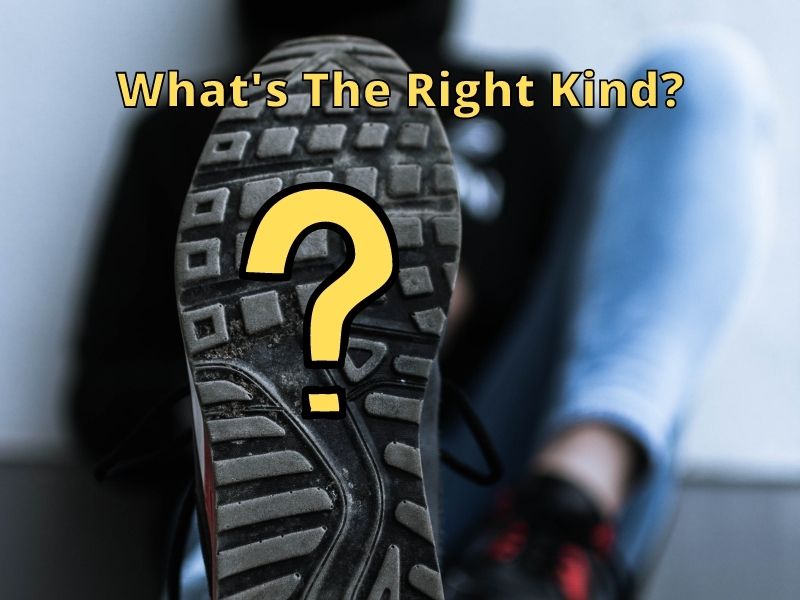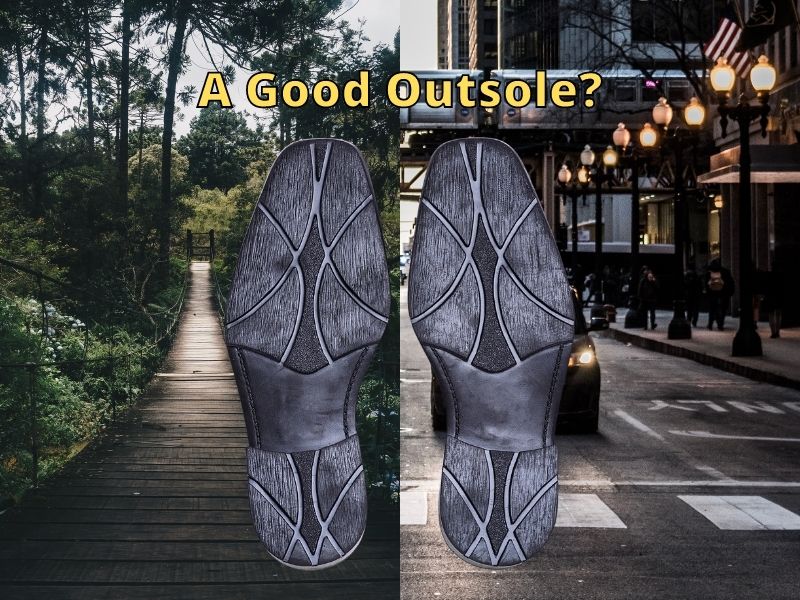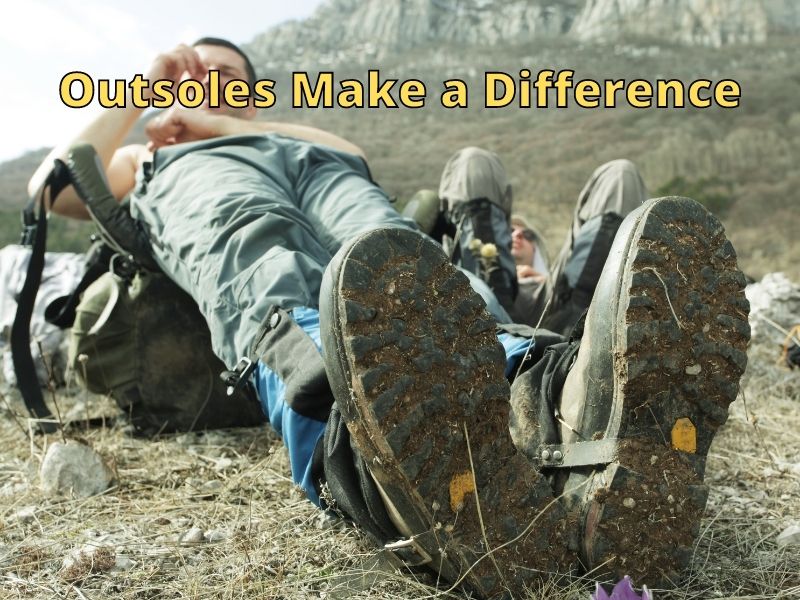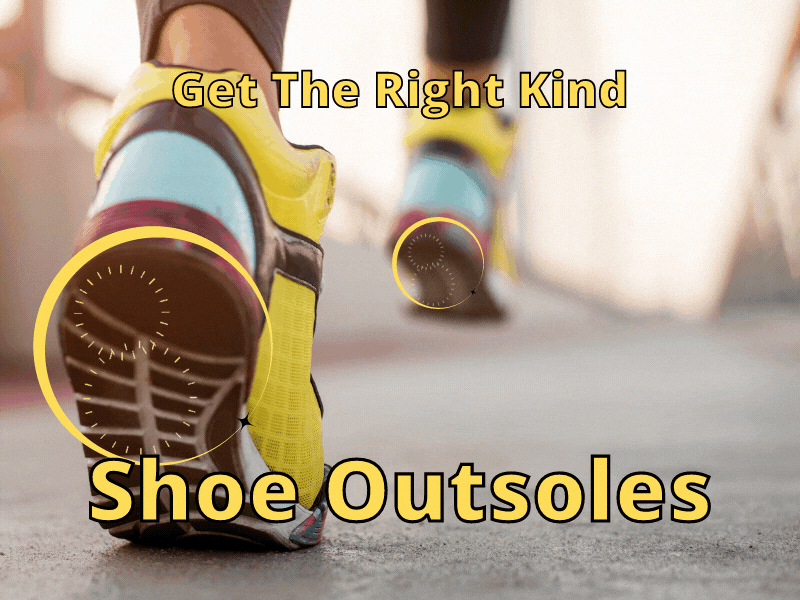Shoes are an essential part of our daily activities. In my experience, whenever I buy my pair of sneakers I look at the design and the price tag. I usually don’t worry about what kind of shoe outsole it has but the outsole can have important implications for many people.
Different shoe outsole serves different purposes so getting the right kind matters. Shoes designed for hiking, running, and basketball all have distinct outsoles designs. So getting the right kind of shoe outsole is a very important factor for preventing unwanted injuries and better performance during your activities.
Choosing the right shoe outsole may seem confusing at first but I will be walking you through the classifications of shoe outsole and their characteristics. Continue reading to be guided to the best outsole for your activities.
What Is A Shoe Outsole?
The shoe outsole is the outermost bottom part of the shoe. It comes in direct contact with the ground and can grip different surfaces depending on the outsole style.
The shoe outsole is meant to create traction and stability. It is usually made to grip certain surfaces and may not do well on other surfaces.
They can be made from several types of materials such as rubber, polyurethane, leather, and other synthetically made materials. The material is combined from different types of outsole types that have various levels of gripping power.
Each outsole also has a different level of durability. Usually the more sticky/grippy it is the faster the tread wears away. So choosing the right ones might be tricky but can help you greatly. The outsole is often referred to as the soul of a shoe because the different kinds make different personalities and purposes.
Shoe manufacturers have already evolved the shoe industry with their creativity and high knowledge of shoe designing.
Luckily with the advances in making shoe soles, it is possible to construct them with whatever properties the shoe company decides that buyer will like.
That’s why newer versions of the same shoe can be so different sometimes. They design shoes that have most of the same attributes but try to make changes that will improve on the past.
Sadly, these different types of shoe outsoles may lead you to wonder which one is the best. Keep reading and we’ll discuss more about how to make the right choice.
Getting The Right Kind Of Shoe Outsole

Getting the right kind of shoe outsole is an important factor because it can give you a chance the activities you love without worrying about damage to your shoes or unwanted injuries.
Since the outsole is most likely the most worn-out part of the shoes getting the right shoe with the appropriate outsole for its purpose will give you so much convenience and enjoyment for any kinds of activities you plan to participate in.
Let me take my experience for example. I live in a tropical country where 90% of the year is hot and humid and the rest are rainy days. That is why I would consider shoes with a good grip for rainy weather as well as comfortability for the hot and humid weather.
So I think choosing the right outsole is a personal choice to parallel what a shoe provides according to your needs.
Here are some tips that I think would help you to get the right kind of shoe outsole:
- Going to the store is a great way to look at and test out different types of outsoles. You can see how it feels and consider if it will work for the circumstances you are interested in.
- Whether at the store or online, research about they materials used in the outsole. These can affect grip and the life of your outsole.
- After you look at the tread of the outsole, you’ll be able to see if it can function well in the environment that you plan to use it. Testing it out is the best option. Find a store that accepts return in case you don’t like something about the outsole after testing.
Read this article for a shoe insole guide.
Different Classifications Of Shoe Outsole And Their Characteristics
In the video above you can see how the midsole and outsole are combined in different ways to create different types of outsoles. Here are some of the materials that shoe companies use and their properties.
Rubber Sole (RB)
Most shoes that I have, have a rubber outsole. Some even have the mark RB for rubber. Rubber Grips well under most circumstances and that’s why it is so widely used.
Rubber is a natural material that can be recycled. Unfortunately, most shoe companies don’t recycle their shoes. It is flexible and works both in hot and cold weather and resists all sorts of chemicals as well. That’s why it is very helpful by itself or as a combination with other materials to create a specialized sole.
So if you need a waterproof and durable sole material, this outsole works great. It may be a bit heavier than other materials at times, but is likely the best of all outsole materials in my opinion.
Polyurethane Soles (PU)
Polyurethane outsoles are generally considered a long-lasting material. They are often combined with other materials to make a unique outsole for a shoe. Shoes with polyurethane soles tend to have a higher cost if they have a special blend of outsole materials.
Many running shoes use polyurethane outsoles so they can last longer when your run on asphalt and concrete most of the time. These shoe outsoles may last longer but they may have a feel that isn’t as springy as rubber.
It is waterproof and can help feet stay warmer in cold weather. These types of soles offer good wear and good flexibility. It is fairly cheap to use and has become a popular type of sole because it is so versatile. All these characteristics make PU soles a good option for use in many kinds of shoes.
BPU
Just like Polyurethane, this material is a durable material for use in shoe soles. It is a little different from PU but acts in the same way to make a water-resistant low-density shoe outsole.
Various types of shoes might want to include this material in their outsoles, such as running shoes and other sports shoes because it is extremely light and tough.
EVA Outsoles
EVA outsoles are generally foam-like in their feel. Sometimes the outsole and the midsole are the same piece on some shoes. This eliminates the need to make an additional outsole and cuts costs.
Many cheaper shoes are starting to use this process of eliminating the outsole so they can make a fairly good shoe at a cheaper cost. The problem lies in the fact that the foam itself is not as grippy as rubber.
These soles can come in a variety of densities and can be mixed with other materials to make a hybrid sole. This way is can grip well and have a soft feel in the midsole and a rubber-like feel on the outsole.
These types of soles are may make a good walking shoe, but when a slippery situation occurs you may find yourself slipping a bit more.
Ethylene Vinyl Acetate, or EVA, is the most commonly used for the midsoles of shoes. It is soft a feels good and absorbs impacts well. It does compress fairly quickly, so shoes with these midsoles might only last 6 months with daily use.
Yet, because it works great at creating a soft and cushiony feel, many walking and running shoes use it to create a combination of materials for the midsole and outsole. Shoe companies advertise how their shoes with EVA are so light, flexible, and soft, and customers agree.
TRP Bottoms
TRP is a Thermoplastic Rubber. Just like rubber, it has many of the characteristics of rubber but is made essentially from plastic.
You may notice that an outsole looks like rubber and acts like rubber but when you feel it, it’s lighter and feels different. This is usually a thermoplastic outsole.
These outsoles are flexible, chemical resistant, probably a bit more resistant to wear than most rubbers, and can grip well, but may not grip as well as rubber.
This is a cheaper way to make an outsole and still get a good shoe outsole, although most people like the feel of rubber, it may be hard to tell when your actually wearing shoes with TPR outsoles.
ABS Outsoles
Acrylonitrile Butadiene Styrene or ABS is a material that like other synthetic materials is strong and resilient. It can resist chemicals, is durable, and resists abrasion.
This is usually a hard plastic-like material that can be found on the heels of women’s shoes. If you look at various sports shoes and hiking boots, you may find a plastic support area under the arch. This might be made of ABS.
This thermoplastic might be found in some shoes but not a much as other materials. It can protect heels but isn’t flexible. (see this article)
PVC Outsoles
PVC is also known as Polyvinyl Chloride is a material that is used in many products including outsoles. I first learned about PVC as piping material for sprinkler systems. (That doesn’t sound like something I’d want on my shoes)
This type of plastic is a cheap way to make different parts of shoes, including the outsole. If you’ve ever worn a cheap pair of flip-flops these are made with foam PVC.
Various densities can be used to make the outsole, but these types of outsoles will feel less like rubber and more like a harder plastic or soft foam.
If you look at your shoe sole you may notice parts of it are a combination of different materials and one may be PVC.
What Makes A Good Outsole?

Environment
A good outsole all depends on the environment you will be using your shoes the most. You’ll notice that most restaurant shoes have highly grippy soles. If you find yourself in slippery situations a lot then these types of shoes would work best for you.
When hiking outdoors, finding a durable and grippy outsole is important. Hiking shoes tend to have knobby tread on their soles so they can grip the outdoor terrain well.
If you are a runner though, you’ll notice most of these types of shoes have thin tread but also tend to grip the road and pavement well.
In general, most shoes meant to be used outside will have rubber soles or a mixture of various materials that provide good grip and durability.
For shoes that are meant for indoor or light outdoor use, possibly some walking, you will find almost any kind of outsole material used. These can be very durable, or not. These can be very comfortable but may not last as long if they are made of foam.
Denser materials will resist wear but may not be as flexible and as comfortable.
Try Your Shoes For Two Weeks
Normally I suggest finding a shoe the feels comfortable from the start. Yet, I ignored my own advice when I made a recent purchase.
Sometimes you don’t know how a shoe will really feel until about two weeks later in my experience. I purchased a pair of trail running shoes and regular running shoes a couple of months back.
These were on sale and I decided to risk buying them, even though they didn’t quite feel comfortable at first. My trail runners were a little stiff and one of my toes kept touching the front of the shoe material from time to time.
Since I could return the shoes if they didn’t work out, I decided to test them out. After two weeks they felt fine and seemed to shape to my foot and now I enjoy using them.
The same thing happened with my running shoes. The soles felt too thin, but now my feet are comfortable when I run in them.
The outsoles on both of these shoes may have need a bit of a break-in period, and my feet may have also needed to adjust to them a bit as well.
Should I Get A Durable Sole?
If you can spend a bit extra for an outsole that will last longer it might be worth it. I had a pair of trail runners that I loved to use when hiking, but after the soles wore out I couldn’t use them anymore. It was sad because it seemed like the midsole still had a lot of life in them.
You may have heard of the Vibram outsole. They are supposed to be durable and still grip well. People like them and I believe my lasted trail running shoes have them, so I get to test them out as well.
It makes sense to get a good outsole if you are paying anything more than $50 for your shoes in my opinion. If you want to wear a pair of shoe you plan to replace in a year or less, getting a cheaper pair with regular outsole make financial sense.
If you plan on using your shoes for years, get thick soles boot or a durable soled shoe so your shoes last. That way if you pay more than $50, you have made a good investment for the future.
Dress Shoes
If you’re looking at dress shoes you will find that leather-soled shoes look nice but won’t last as long as a durable synthetic sole.
It’s best to buy a pair of shoes where the sole can be replaced if you plan on having them for 5+ years. Most quality leather shoes can easily last for 5 years with monthly care.
Comfort
The outsole of your shoes can impact comfort, so it is a good idea to try new shoes on first before you buy them. The outsole of a hiking boot for example will need a break-in period and may not feel comfortable at first.
Yet, most shoes you buy should feel comfortable the first time you put them on, so try your best to find comfortable shoes. This is helpful because some shoes never get comfortable even after several weeks of wearing them.
I like to take a shoe and push on the heel and toes and see how much and where the shoe bends. For example, a good walking shoe should be fairly flexible and bend at the ball of the foot with little effort most of the time.
Importance Of A Shoe Outsole

We oftentimes neglect to identify which type of outsole we purchase, maybe because we desire to purchase a shoe from a brand we like or we decide to purchase shoes bases on how they look with our outfit.
Every step we take can occur to various injuries and that’s a big factor to look at. I remember when I purchased a shoe designed for skating and used it for hiking and it made my feet sore because apparently, the outsole wasn’t thick enough to protect my feet from uneven and slippery trails.
It gave me a nightmare and made me not want to hike again. But as I try to regain more knowledge from my mistakes I have learned that shoes are not made for all types of drastic and light activities.
Shoes can take us to various places and we should take the ones that can help us with full convenience and comfort. I mean, why choose shoes that are only beautiful outside but not entirely made for certain circumstances.
For us to fully enjoy outdoor activities, it’s helpful to get shoes that fit well, have a design that looks nice but mostly ones that work best for the activity we want to engage in.
Final Thoughts
We often choose our clothing according to the weather outside, the same should go with shoe outsoles. We should choose the most appropriate outsole that can handle each circumstance or activity we plan to do.
Shoes are an essential part of our daily activities and in my experience, whenever I buy my pair of sneakers I try to consider the shoe as a whole including its outsole when making my decision to purchase shoes.
The shoe outsole may not be very noticeable but choosing the right kind is important for your overall satisfaction when wearing and using your shoes each day.
Thanks for visiting Helpshoe.com

